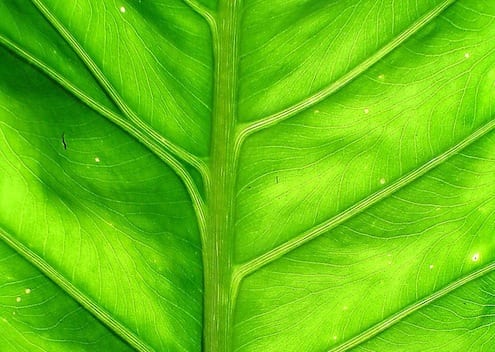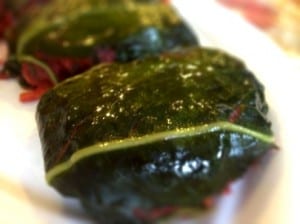A fun and delicious take on the classic dolmades, with taro leaves and an Indian inspired stuffing.
By Priya Mahadevan

Almost every dish from every cuisine has a counterpart in another cuisine – This may be a rather sweeping statement, but it is not too far from the truth. And if they don’t it is easy enough to adapt it to your own cuisine.
This is sort of what I did with this recipe. I had these beautiful BIG Taro leaves hitting me in the eye and I knew they were edible and what’s more very tasty too.
For those of you who have not tasted taro roots, these have a brown hairy inedible skin and when peeled and roasted can taste a lot like potatoes. Taro roots are used in many different Indian preparations, depending on which part of the country you are from – The roasted south Indian version is best known to me and best liked too.
When they are boiled and peeled, they do assume a rather slimy and squishy texture and that to me was not appealing  for the longest time and to date I am squeamish about touching these. When we visited Pune a couple of years ago, I saw these teeny tiny kinds that the cook of the house just pinched the skins off without boiling them – She also peeled them before cooking them, an idea I have yet to try.
for the longest time and to date I am squeamish about touching these. When we visited Pune a couple of years ago, I saw these teeny tiny kinds that the cook of the house just pinched the skins off without boiling them – She also peeled them before cooking them, an idea I have yet to try.
But getting back to the leaves, I made a green gravy type dish with it earlier and that tasted amazing. Their mere size lends itself to a wrapped dish of sorts. And ever since we tasted the dolmas in the Middle East, I have loved them, had various not to great versions of them back home in the US. They can be really oily and the rice stuffing always made me feel a bit guilty. Here I was with the taro leaves (have yet to buy grape leaves) and the remainder of the stuffing from the sweet-beet samosas and I said … hmm (not rubbing my chin) and this is what resulted from it. A sensational dish – which you’ve got to try in your own kitchen should you be fortunate enough to come across these leaves.
PrintTaro Leaves Dolmades
- Total Time: 30 minutes
- Yield: 2-4 1x
Description
A sensational dish – which you’ve got to try in your own kitchen should you be fortunate enough to come across these leaves.
Ingredients
- 1 extra large Taro Leaf
- Stuffing of your choice (I plan to try other stuffing as well)
- For this I used left over
- sweet potato,
- beetroots
- paneer
- Salt
- 2 green chilies (hot ones)
Instructions
- Wash the leaf – they are like lotus leaves and the water just rolls off them
- Cut the stem so you can lay them some what flat
- The leaf has wonderful ridges to cut right along them – I made my cuts about 4-5 inches wide tapering down to the main stem, following the ridge.
- Place the stuffing in the middle and fold over, there should be enough leaf for a generous fold over and wrap.
- Repeat until all the stuffing is used – An extra big leaf allows you at least 6-8 wraps.
- Spray the outside with olive oil or
- With a brush gently smear some oil over the wraps
- Place in your steamer (idli steamers will work too) and cook on medium heat for 12- 15 min.
- Indication of a cooked leaf is it will turn dark green and look oily.
Notes
The stuffing can be made in any way you deem fit – the only consideration being it needs to be solid/ water-free. Rice is the stuffing in traditional dolmades
- Prep Time: 10 mins
- Cook Time: 20 mins
WARNING: Taro roots and leaves are very high in calcium oxalate and should NEVER been consumed raw – Matter of fact well cooked/fried are the best ways to go. Calcium Oxalate causes kidney stones, but all burns right through your mouth, throat and esophagus if eaten raw – the remedy should one accidentally consume it raw is 1) benedryl to avert allergic reactions 2) cold milk/buttermilk/ 3)tums or other calcium supplement to ease the irritation of the stomach lining. (as you may guess, this is the voice of experience)












Dear Sivam,
Let me tell you that Taro leaves need to be cooked to death – It is very high in oxalates and cooking them nicely gets rid of it, almost. They taste fabulous, as I already wrote. So if you want to make a kootu or just a side subji of it, just chop them fine and pressure cook it along or separate from the dal. You could also try soaking it in lime juice or tamarind water- these are experiments I have not done, but ideas that are coming to mind as I write this.
Good luck :)
Priya
Dear Priya, spent long time to find out how some one cooks just taro leaves. almost all of them has pigs or chick peas in it . Can taro leaves go by itself like in the palak panneer, with out the panneer in it.I suppose steam just the leaves blend it and add to the spices. some times it can have a dhal like south Indian way. Patra wadi needs more time and is steamed about 15 minutes and eaten, so steam just the leaves blend and mix with spice or saute. I have market bought taro planted last year and leaves came out beautifully, now it is in side waiting to go out. Lots leaves, not as big as with sun, but looks healthier. When i was visiting India I told our friend Nagpoorien, to bring taro leaves from Nagpore, she didn’t bring. Here i am in Seattle moderate cold,zone 8-9 I have taro leaves growing. Love to your family. Sivam